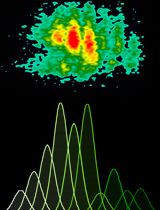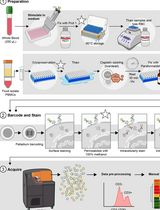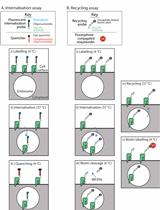- EN - English
- CN - 中文
Flow-cytometric Detection of Low-level Reactive Oxygen Species in Cell Lines and Primary Immune Cells
细胞系和原代免疫细胞中的低水平活性氧的流式细胞仪检测
发布: 2020年09月05日第10卷第17期 DOI: 10.21769/BioProtoc.3737 浏览次数: 7009
评审: Kristin L. ShinglerMathias HauriAnonymous reviewer(s)

相关实验方案

使用康可藻红素刺激冷冻保存的猪外周单个核细胞进行增殖检测,并结合FCS ExpressTM 7.18软件分析
Marlene Bravo-Parra [...] Luis G. Giménez-Lirola
2025年06月05日 2392 阅读

用于比较人冷冻保存 PBMC 与全血中 JAK/STAT 信号通路的双磷酸化 CyTOF 流程
Ilyssa E. Ramos [...] James M. Cherry
2025年11月20日 1846 阅读
Abstract
Depending on its concentration and cellular origin the production of reactive oxygen species (ROS) in the organism serves a variety of functions. While high concentrations during an oxidative burst are used to fight pathogens, low to moderate amounts of ROS act as signaling molecules important for several physiological processes such as regulation of immune responses. The ROS-sensitive dye 2',7'-dichlorodihydrofluorescein diacetate (H2DCFDA) is an inexpensive and well-established tool for measuring intracellular ROS levels. However, it needs to be carefully controlled to be able to draw firm conclusions on the nature of ROS species produced and the cellular source of ROS generation such as the enzyme complex NADPH-oxidase 2 (NOX-2). In this protocol, a robust method to determine low intracellular ROS production using H2DCFDA was validated by several ROS-specific as well as NOX-2-specific inhibitors. Cells were treated with inhibitors or control substances prior to treatment with the ROS-inducer of interest. H2DCFDA was added only for the last 30 min of the treatment schedule. To terminate its conversion, we used a ROS-specific inhibitor until analysis by flow cytometry within the FITC-channel (Ex: 488 nm/Em: 519 nm). In summary, this protocol allows the detection of signaling-relevant intracellular ROS production in cell lines and primary immune cells (e.g., Mono Mac 6 cells and Bone marrow-derived dendritic cells, respectively). Using this method in combination with specific inhibitors, we were able to validate even exceptionally low amounts of ROS produced by NOX-2 and relevant for immune-regulatory signaling.
Keywords: Reactive Oxygen Species (ROS) (活性氧(ROS))Background
Reactive oxygen species (ROS) can be generated in different cellular compartments such as peroxisomes, the cytosol, at mitochondrial membranes, or at the plasma membrane (Di Meo et al., 2016). High concentrations of ROS can damage all major cellular constituents and are, thus, a lethal threat for living organisms. High amounts of ROS produced in a short period of time (often called oxidative burst) are important for the immune system to fight pathogens. Persistence of excessive ROS production is associated with several diseases such rheumatoid arthritis, diabetes mellitus and neurodegenerative diseases. Low concentrations of superoxide anions (O2-) and derivatives thereof, however, have been described to act as essential regulators in cellular signaling cascades (Dröge, 2002). The plasma membrane-bound complex NADPH-oxidase 2 (NOX-2) is one of the main O2- producers in phagocytes such as dendritic cells, macrophages, and neutrophils. The active NOX-2 complex is formed by 6 subunits (gp91phox, p22phox, Rac2, p40phox, p47phox and p67phox), which allow a tight regulation of NOX-2 activity. NOX-2 can produce both, low and high levels of O2- that are rapidly converted into hydrogen peroxide (H2O2; Giardino et al., 2017; Belambri et al., 2018). H2O2 is comparatively stable and is responsible for both, intra- and extracellular effector functions. High amounts of NOX-2-derived O2- produced by neutrophils in phagosomes are important to kill bacteria via direct oxidative damage. In contrast, low concentrations of H2O2 fulfill essential intra- as well as intercellular second-messenger functions for the regulation of, e.g., immune responses (Bienert et al., 2006; Holmdahl et al., 2013). Thus, H2O2 were demonstrated to enhance the expression of interleukin-2 in activated T cells (Roth and Dröge, 1987) and to inhibit the secretion of pro-inflammatory cytokines in phagocytes (Jendrysik et al., 2011; Sareila et al., 2011; Singel and Segal, 2016; Bode et al., 2019). Accordingly, loss of functional NOX-2 has been associated with dysregulated immune responses and several autoimmune diseases such as Lupus erythematosus and Crohn’s-like inflammatory bowel disease (Lee et al., 2011; O’Neill et al., 2016; Rosenzweig, 2008; Singel and Segal, 2016).
Several protocols have been established for the detection of free radical production in cells which use either lucigenin, chemiluminescence of luminol, xylenol orange or 2',7'-dichlorodihydrofluorescein diacetate (H2DCFDA) as tools for the detection of intracellular ROS production (Gyllenhammar, 1987; Dahlgren and Karlsson, 1999; Nourooz-Zadeh, 1999). H2DCFDA is one of the most frequently used chemicals to investigate the intracellular redox state. Other sensitive and direct approaches for measuring H2O2 have also been described such as the Amplex Red Hydrogen Peroxide/Peroxidase Assay Kit (Karakuzu et al., 2019). However, this relatively expensive tool measures extracellular H2O2 and might not detect low amounts of intracellular ROS. In contrast, low cost, easy handling, high sensitivity, and the possibility to use it in kinetic approaches are important advantages of H2DCFDA over other established tools. H2DCFDA enters cells by diffusion and is converted into the non-permeable derivate H2DCF, which can then be oxidized by ROS into fluorescent 2’,7’-dichlorofluorescein (DCF). An alternative protocol for measuring ROS using H2DCFDA has been published by Eruslanov and Kusmartsev (Eruslanov and Kusmartsev, 2010). Of note, H2DCFDA lacks specificity for O2- radicals and instead reacts with several O2-/H2O2 conversion products such as alkoxyl, carbonate, peroxyl, NO2-, as well as OH- radicals (Ischiropoulos et al., 1999; Bilski et al., 2002; Eruslanov and Kusmartsev, 2010). Moreover, H2DCFDA is prone for artificial conversion mediated, e.g., by light exposure or by direct or indirect oxidation via cytochrome c released during apoptosis (Kalyanaraman et al., 2012). Hence, the detection of ROS by H2DCFDA must be carefully controlled to confirm cell-dependent ROS production as well as the enzyme of origin such as NOX-2 (Bilski et al., 2002; Ohashi et al., 2002; Eruslanov and Kusmartsev, 2010). In order to further specify the source and species of the measured ROS, different ROS-specific inhibitors (6-Hydroxy-2,5,7,8-tetramethylchroman-2-carboxylic acid; Trolox, N-Acetyl cysteine; NAC, and catalase) as well as NOX-2-specific inhibitors (sgp91 ds-tat and GSK2795039) are highly recommended.
The following protocol incorporates the use of specific inhibitors to enable a robust detection of low ROS levels in cell lines (Mono Mac 6 (MM6) cells, Jurkat T cells, etc.) and primary immune cells (Bone marrow-derived dendritic cells, etc.). Next to the use of inhibitors as pre-treatment to differentiate source and species mediated by the ROS-inducer of interest (see Table 1), the general ROS scavengers Trolox or NAC are used to stop the reaction of H2DCF to DCF at the end of the experimental treatment. The latter ensures that only ROS which are produced during the experimental setting are measured and prevents unwanted conversion not related to the treatment such as responses to stress during washing and the final measurement. By using this protocol, highly reproducible detection of intracellular ROS production in signaling-relevant concentrations can be performed (Bode et al., 2019).
Materials and Reagents
- 48-well plates, non-treated (CytoOne, STARLAB GmbH, catalog number: CC7672-7548 )
- 48-well plates, tissue culture (tc) treated (greiner cellstar plate, Sigma-Aldrich, catalog number: M8937-100EA )
- 96-well plate (U-shape, LIFE Technologies, catalog number: N8010560 )
- Jurkat E6.1 T cells (Schneider et al., 1977, CVCL_0367); cultured in RPMI/10% FCS [v/v]
- Mono Mac 6, MM6 (Ziegler-Heitbrock et al., 1988, CVCL_1426); Dectin-1-overexpressing MM6 cells were generated previously (Bode et al., 2019); cultured in RPMI1640/10% FCS/1% OPI [v/v]
- Bone marrow-derived dendritic cells (BMDCs); See Bode et al. (2019) for further information BMDC generation
- Bovine extracted catalase (Carl Roth, catalog number: 6025.1 ), storage at -20 °C, powder shelf-life ≥ 6 months, in solution only 1 day
- Trolox (Th. Geyer, catalog number: CAY10011659-250 ), storage at 4 °C, powder shelf-life ≥ 6 months, in solution only ≤ 3 weeks
- Dimethyl sulfoxide, sterile-filtered (BioPerformance Certified, Sigma-Aldrich, catalog number: D2438 )
- sgp91 ds-tat, scrambled (Anaspc, catalog number: AS-63821 ), storage at -20 °C, shelf-life ≥ 24 months, avoid repeated freeze and thaw cycles
- gp91 ds-tat (Anaspc, catalog number: AS-63818 ), storage at -20 °C, shelf-life ≥ 24 months, avoid repeated freeze and thaw cycles
- GSK2795039 (MedChem Express, catalog number: HY-18950 ), storage at -20 °C, shelf-life ≥ 3 months, avoid repeated freeze and thaw cycles
- RPMI 1640 (Sigma-Aldrich, catalog number: R8758-500ML )
- Fetal calf serum, FCS (Sigma-Aldrich, catalog number: 12133C-500ML ), storage at -20 °C, shelf-life ≥ 12 months
- OPI-supplement (Sigma-Aldrich, catalog number: O5003 ), storage at -20 °C, shelf-life ≥ 12 months
- Polymyxin B sulfate salt (Sigma-Aldrich, catalog number: P4932 ), storage at 4 °C, powder shelf-life ≥ 12 months, in solution only ≤ 2 weeks
- H2DCFDA (Sigma-Aldrich, catalog number: D6883 ), storage at -20 °C, shelf-life ≥ 24 months, avoid repeated freeze and thaw cycles
- N-acetyl cysteine, NAC (Sigma-Aldrich, catalog number: A7250 ), storage at 4 °C, shelf-life ≥ 6 months but in solution only 1 day
- Phorbol-12-myristat-13-acetate (PMA; Sigma-Aldrich, catalog number: P8139-1MG ), storage at -20 °C, shelf-life ≥ 6 months but in solution only 1 day, avoid repeated freeze and thaw cycles
- Depleted zymosan (DZ; Invivogen, catalog number: tlrl-zyd ), storage in solution at -20 °C, shelf-life ≥ 12 months, avoid repeated freeze and thaw cyclesGibcoTM PBS, pH 7.4 (Thermo Fisher Scientific, catalog number: 11503387 )
- 500 mM H2DCFDA solution (see Recipes)
- 100 mM Trolox solution (see Recipes)
- 100 mM NAC solution (see Recipes)
- 1 mM Trolox stop solution (see Recipes)
- 1 mM NAC stop solution (see Recipes)
- Catalase mixture (ca. 10,000 U/ml) (see Recipes)
- gp91 ds-tat, scrambled solution (see Recipes)
- gp91 ds-tat solution (see Recipes)
- GSK2795039 solution (see Recipes)
Equipment
- Incubator (Heracell VIOS 160i, Thermo Fisher Scientific or similar product with the adjustment of 37 °C and 5% CO2)
- Centrifuge (Thermo Scientific Multifuge X1R Multi-Application, Thermo Fisher Scientific or similar product with 96-well inlay)
- Single channel pipette, 2-20 µl (Gilson, catalog number: F144056M ; or similar product), use appropriate standard pipette tips (sterilized)
- Single channel pipette, 20-200 µl (Gilson, catalog number: F144058M ; or similar product), use appropriate standard pipette tips (sterilized)
- 8-channel pipette, 30-300 µl (Eppendorf Research, catalog number: 3125000052 ; or similar product), use appropriate standard pipette tips (sterilized)
- Flow cytometer (FACSCanto II, BD Biosciences)
Software
- Graph Pad Prism, version 6 (PrismGraphPad Software Inc., SCR_002798)
- FlowJo, version 7.6.5 (BD Biosciences, SCR_008520)
Procedure
文章信息
版权信息
© 2020 The Authors; exclusive licensee Bio-protocol LLC.
如何引用
Bode, K., Link, C., Krammer, P. H. and Weyd, H. (2020). Flow-cytometric Detection of Low-level Reactive Oxygen Species in Cell Lines and Primary Immune Cells. Bio-protocol 10(17): e3737. DOI: 10.21769/BioProtoc.3737.
分类
免疫学 > 免疫细胞功能 > 综合
免疫学 > 免疫细胞染色 > 流式细胞术
细胞生物学 > 细胞信号传导 > 胞内信号传导
您对这篇实验方法有问题吗?
在此处发布您的问题,我们将邀请本文作者来回答。同时,我们会将您的问题发布到Bio-protocol Exchange,以便寻求社区成员的帮助。
提问指南
+ 问题描述
写下详细的问题描述,包括所有有助于他人回答您问题的信息(例如实验过程、条件和相关图像等)。
Share
Bluesky
X
Copy link











